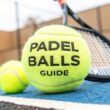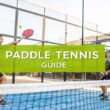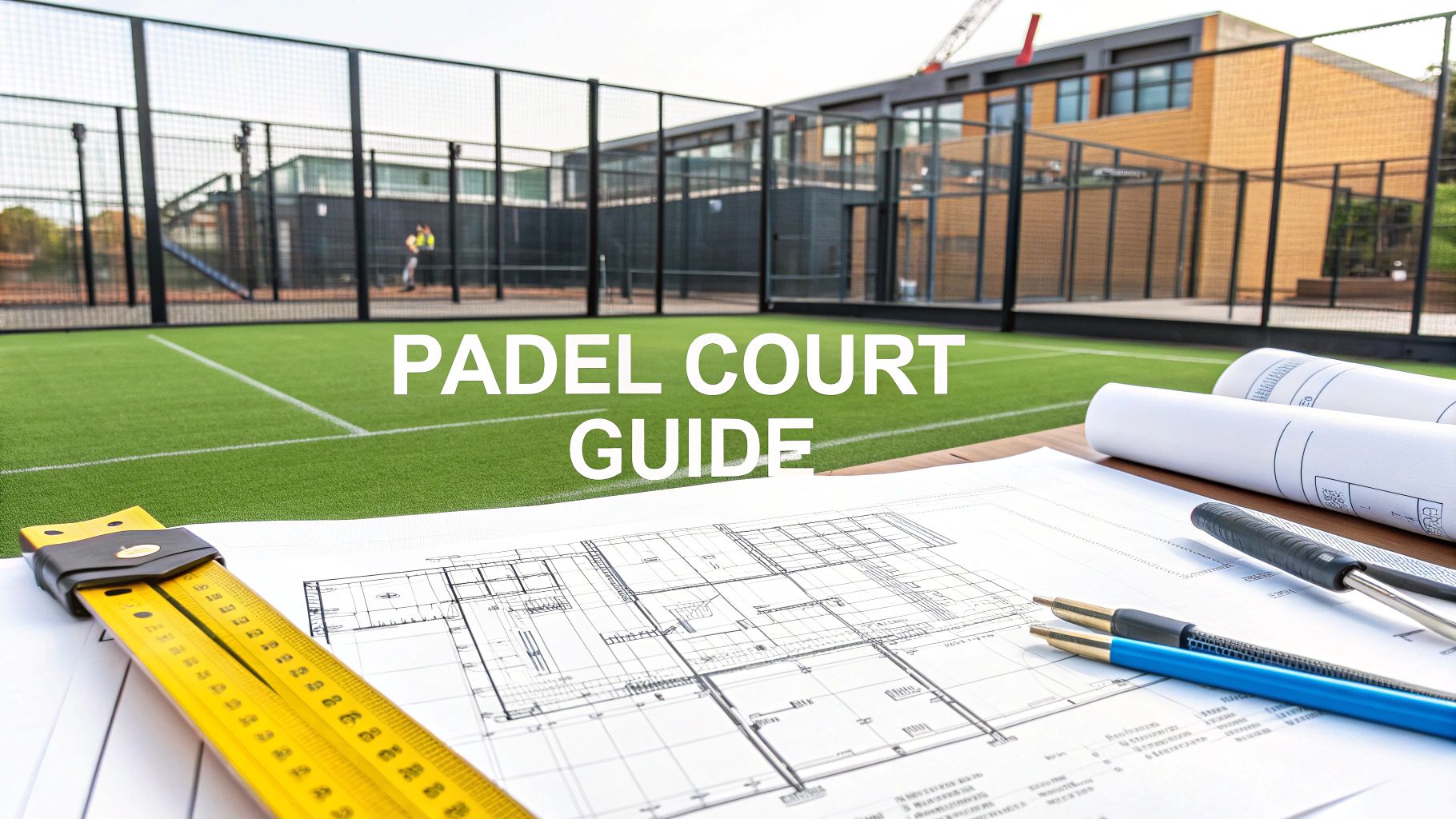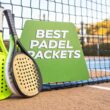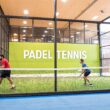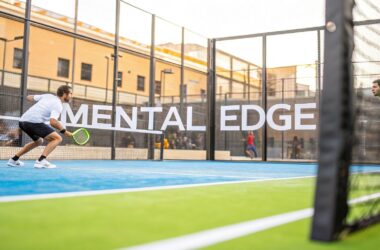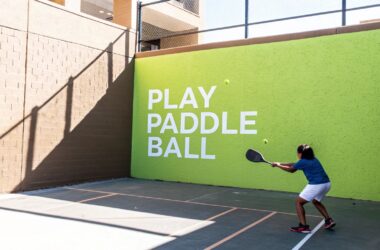A padel court is a whole different beast compared to what you see in tennis or squash. It's a purpose-built, enclosed arena that basically mashes up the best parts of both sports. The court itself is smaller than a tennis court—a neat 10 meters wide by 20 meters long—and it's completely surrounded by a mix of glass and mesh walls. The crazy part? Those walls are totally in play.
So, What's the Big Deal with Padel Courts?
The explosion of padel from a little-known sport to a global obsession is one of the wildest stories in sports right now. But what is it about this glass box that has millions of people hooked? It’s simple: a padel court is more than just a place to play; it’s a social hotspot.
Unlike the wide-open, sometimes intimidating feel of a tennis court, a padel court’s enclosed space creates a much more intimate and energetic vibe. The glass and mesh walls keep the ball flying, leading to way longer rallies and incredibly exciting points right from the get-go. This design makes it super accessible for beginners, who can have a blast and feel successful without needing the massive serves or pinpoint accuracy tennis demands.
The Global Demand is Off the Charts
This isn't just a feeling; the numbers are staggering. Padel courts are popping up everywhere at a mind-blowing pace, which says a lot about how much people love the game.
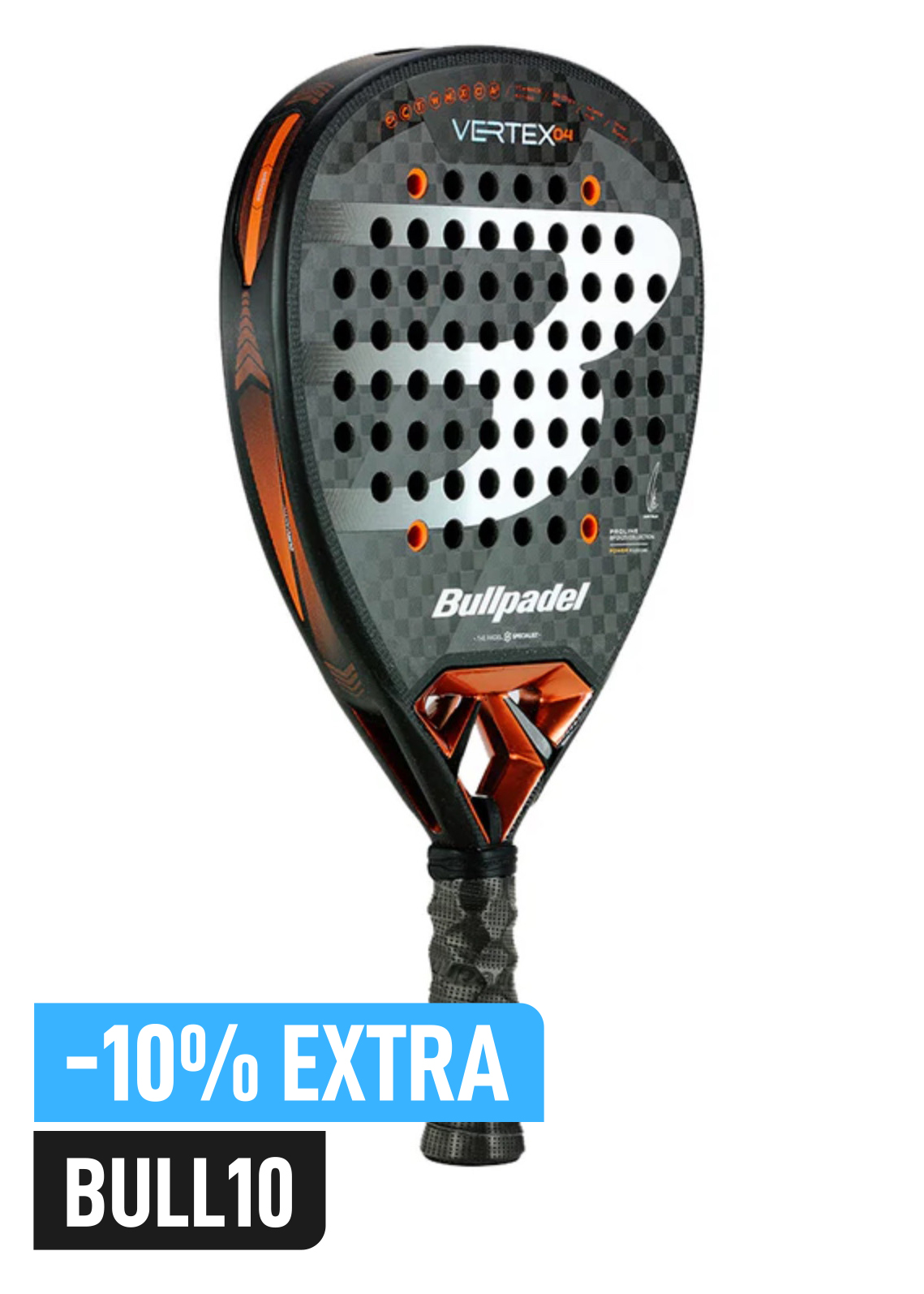
Buy the best padel gear to level up your next game!
CHECK OUT this deal from Padel Market!Get ready to take your game to the next level with the latest padel gear from Padel Market! Fast EU and Worldwide Shipping
In just the last year, a whopping 3,282 new padel clubs opened their doors in over 90 countries. That works out to a new club opening somewhere in the world every 2.5 hours. This boom has pushed the global court count past 50,000, and it's not slowing down—experts predict we'll hit 81,000 soon. You can dive deeper into these stats over at FloridaTennis.com.
This isn’t just a trend; it’s a major shift in what people want from a recreational sport. They're looking for something that’s easy to pick up, a great way to hang out with friends, and just plain fun from the first swing.
It's More Than a Sport—It's a Social Scene
The real genius of the padel court is how it’s built for social connection. The smaller space and doubles-only format mean you’re constantly talking and working with your partner. It naturally builds a sense of community, turning the courts into lively hubs where people stick around to chat and hang out long after the match is over.
In this guide, we'll break down everything you need to know about the modern padel court, from what it’s made of to how you can get one built yourself.
Deconstructing the Modern Padel Court
To really get padel, you first have to understand the court itself. It’s not just a place to play; it’s a thoughtfully designed arena where every single element—from the turf under your feet to the glass walls—shapes the game’s blistering pace and tactical depth. Unlike an open tennis court, a padel court is its own little ecosystem, built for strategy and non-stop action.
The heart of every official padel court lies in its exact dimensions. The playing area is a rectangle measuring precisely 20 meters long and 10 meters wide. That compact size isn't random; it's the secret ingredient that makes the game so addictive and easy to pick up. It naturally pulls players closer together, sparking quick-reflex volleys and rewarding clever shot placement over raw power.
This unique layout means the game is less about sprinting across huge distances and more about smart positioning and lightning-fast exchanges. To give you a clear picture, this diagram breaks down the standard measurements of a modern padel court.
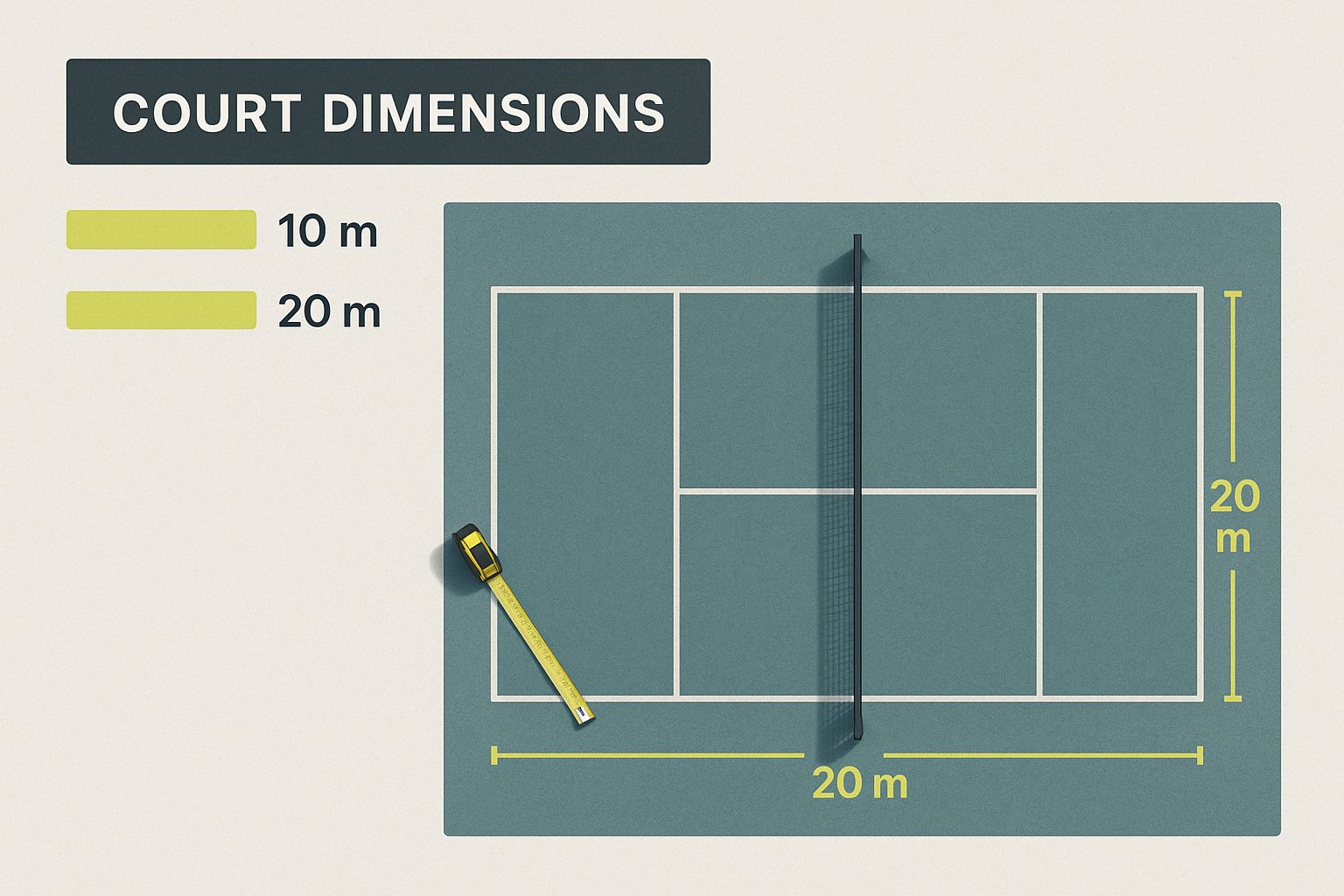
As you can see, the court’s smaller footprint is absolutely core to the sport’s identity, making sure that a game in Spain feels just like a game in Sweden. If you want to get really granular with the measurements, check out this complete overview of padel court size.
The Playing Surface Underfoot
The ground you're playing on has a huge say in everything from how the ball bounces to how your knees feel the next day. Think of the surface as the court's personality—it sets the tempo and style of play. While you might see a few different types, artificial turf is the undisputed king for modern padel courts.
But this isn't the plastic stuff you see in a front yard. It’s a high-tech surface, usually made of monofilament or fibrillated fibers, with a light dusting of silica sand spread across it. That sand is key. It helps control the ball's speed, gives you just enough grip to pivot without sticking, and protects the turf from getting worn down too quickly.
You'll occasionally find courts with other materials like synthetic clay or even concrete, but they completely change the game. Synthetic clay, for example, really slows things down for longer rallies, while a hard court speeds up play and can be a lot tougher on your joints.
The Walls: An Extra Player on Your Team
What truly makes a padel court iconic are its surrounding walls. The enclosure is a mix of tempered glass panels and tough steel mesh, and these aren't just boundaries—they are an active part of the game. This is where padel brilliantly borrows a concept from squash, turning a 2D game into a 3D puzzle.
The back walls are typically made of 10 to 12 mm thick tempered glass to give you a clean, predictable bounce. The side walls are a combination of that same glass and wire mesh. Learning how to use these walls isn't just a trick; it's a fundamental skill.
Players often say the walls act like an "extra player." A ball that looks like it's flying out can be played off the back glass, giving you a second chance to whip it back over the net and turn defense into a surprise attack.
This single feature unlocks incredible creativity. You’ll see everything from gentle bajadas (lobs played off the glass) to ferocious smashes that rebound off the back wall for a clean winner. It’s this constant interaction with the enclosure that makes padel so deeply strategic and fun to watch.

Buy the best padel gear to level up your next game!
CHECK OUT this deal from Padel Market!Get ready to take your game to the next level with the latest padel gear from Padel Market! Fast EU and Worldwide Shipping
Comparison of Padel Court Playing Surfaces
Choosing the right surface is a big decision, as it dictates the feel and cost of the court. Here’s a quick breakdown to help you compare the most common options.
| Surface Type | Ball Speed & Bounce | Player Comfort | Maintenance Level | Estimated Lifespan |
|---|---|---|---|---|
| Artificial Turf | Medium-fast speed, consistent bounce. Sand infill adjusts pace. | High. Good shock absorption, reducing stress on joints. | Moderate. Requires regular brushing and sand redistribution. | 8-10 years |
| Synthetic Clay | Slow speed, high bounce. Favors longer rallies. | Excellent. Very soft underfoot and allows for sliding. | High. Needs frequent watering and grooming to stay consistent. | 10-15 years |
| Concrete/Acrylic | Fast speed, low bounce. Rewards aggressive, flat shots. | Low. Hard surface offers minimal cushioning for joints. | Low. Generally requires just sweeping and occasional resurfacing. | 15-20 years |
Ultimately, while clay and concrete have their place, the combination of performance, player safety, and reasonable upkeep is why artificial turf remains the go-to surface for most padel courts around the world.
The Essential Guide to Padel Court Lighting
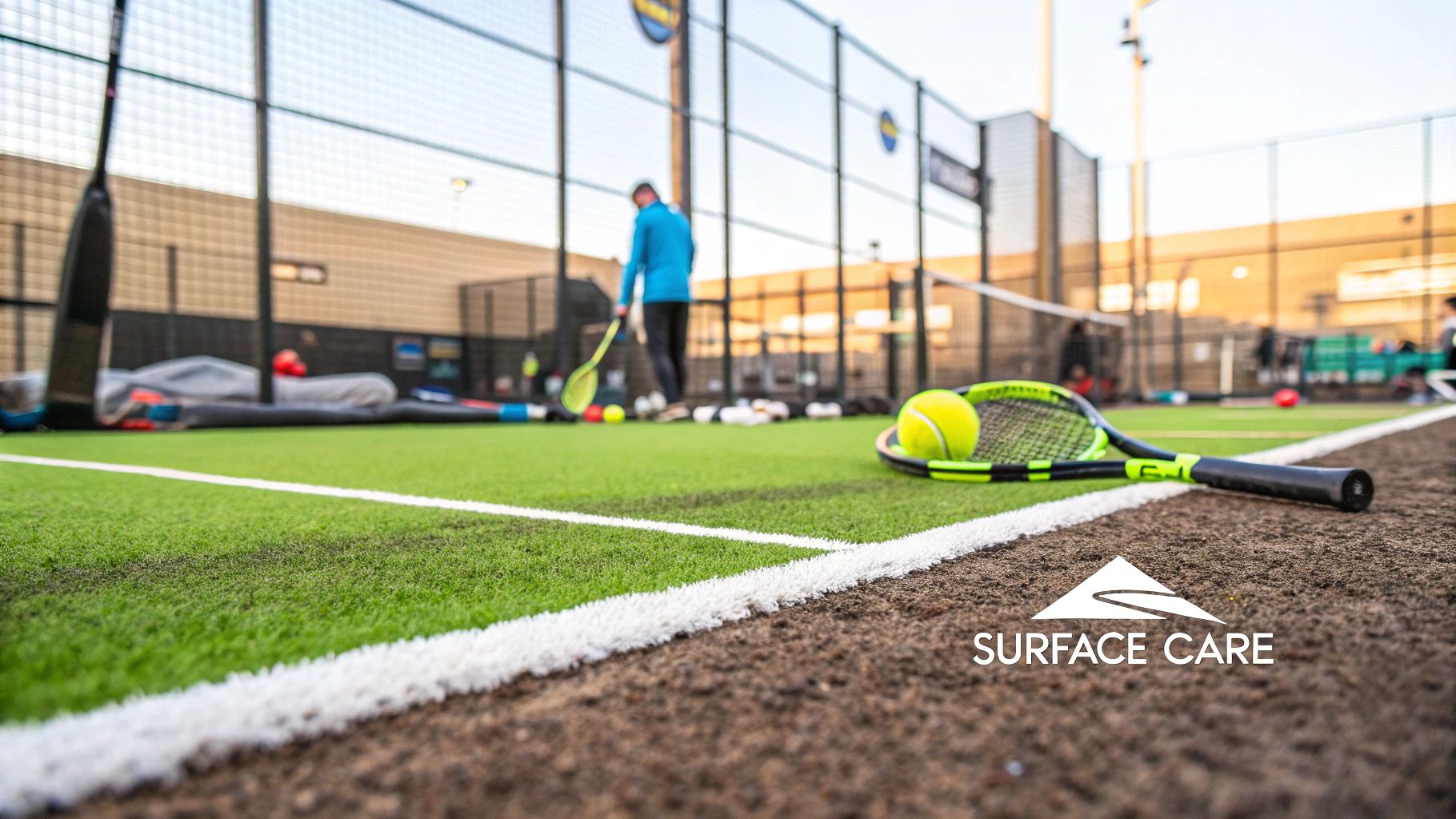
Good lighting is what turns a padel court from a daylight-only spot into a 24/7 asset. It’s what lets clubs extend playing hours, bring in more revenue, and give players a top-notch, safe experience long after sunset. Think of it less like just turning on some lights and more like painting the court with perfect, even visibility.
You see, great lighting isn't just about being bright. It's about getting rid of those annoying shadows and harsh glares that can completely throw off a player's concentration. The magic word here is uniformity—making sure every inch of the playing surface is lit consistently. This lets players track that fast-moving ball without their eyes constantly struggling to adjust between bright spots and dark patches.
Setting the Standard with Lux Levels
We measure illumination in a unit called lux. How many lux you need really boils down to who's using the court. A casual court for a friendly weekend hit-around has very different lighting needs than one hosting a professional tournament for TV broadcast.
- Recreational Play (Class III): For amateur games and general training, 200 lux is the baseline. It’s plenty of light for safe, fun play without the intensity (and cost) of a pro setup.
- Club and Tournament Play (Class II): When things get more serious at the club level or for regional tournaments, you’ll want to bump it up to 300-500 lux. This extra brightness makes a huge difference for both players and spectators.
- Professional Competition (Class I): For the big leagues and televised events, courts need over 500 lux. This high-intensity lighting is crucial for broadcast cameras to capture crisp, clear action and for players to perform at their absolute peak.
Padel is blowing up globally, and that means more courts need elite lighting to keep up. Right now, there are roughly 63,000 padel courts spread across 20,000 clubs worldwide. With the sport growing at about 26% year-over-year in terms of court construction, getting the lights right has never been more important.
The Dominance of Modern LED Systems
When it's time to light up a modern padel court, LED technology is the only real contender. Old-school metal halide or halogen lamps just can't compete anymore; they’re inefficient, burn out quickly, and are being phased out for good reason. LEDs, on the other hand, bring a whole host of benefits to the table.
LED lights can slash energy consumption by up to 75% compared to traditional lighting. Plus, with a lifespan of 50,000+ hours, they dramatically reduce maintenance headaches and replacement costs, making them a much smarter investment in the long run.
On top of the savings, LEDs just produce better quality light. They have a superior Color Rendering Index (CRI), which means the court, the ball, and what the players are wearing all look more vibrant and true-to-life. If you're diving into a new build or an upgrade, checking out a professional guide to LED lighting installation can give you a ton of valuable insight.
Typically, you’ll see anywhere from four to eight lighting poles placed strategically outside the glass walls. This placement is key to casting that smooth, uniform light across the court and, most importantly, keeping glare out of the players' eyes.
Your Padel Court Construction Blueprint
Turning a patch of dirt into a buzzing padel court is a serious project. It's less like DIY and more like assembling a life-sized, high-performance machine where every single piece—from the concrete base to the last grain of sand on the turf—has to be perfect. Let's walk through the blueprint to get you from an empty space to game time.
Laying the Groundwork: Site and Permits
The real work starts long before any construction crew shows up. Your first job is site selection and preparation, and it’s arguably the most important. You can't just pick any spot. You need a flat, stable area with fantastic drainage. If water pools, it’ll wreck your foundation and playing surface, leading to a swampy mess.
Think of the foundation as the court’s anchor. A weak one will cause cracks, uneven spots, and repairs that will make your wallet cry. A professional job almost always starts with a reinforced concrete slab, usually around 15-20 cm thick, creating a perfectly level and unmovable platform.
Don't Skip the Paperwork
Before you get too excited, you have to deal with the red tape. Building a padel court usually requires planning permission from your local authorities. This means you'll be submitting detailed plans showing dimensions, materials, and exactly where it will sit on your property.
Rules can be wildly different depending on where you live. Keep an eye out for:
- Zoning Laws: Is the land actually cleared for recreational use?
- Proximity to Boundaries: There are often rules about how close you can build to your neighbors.
- Lighting Restrictions: Nobody likes a stadium light blasting through their bedroom window. There are often regulations to control light spillage, especially near homes.
Trying to skip this step is a guaranteed way to cause a massive headache. You could be hit with huge fines or even an order to tear the whole thing down. Always talk to your local council or a specialist builder first.
Putting the Pieces Together
Once the foundation is solid and the permits are in hand, the fun part begins: building the iconic padel cage. This is where the steel frame, glass walls, and mesh fencing all come together. It's a precise process that needs a skilled team.
- Frame Installation: First, the steel posts get bolted straight into the concrete slab. This creates the skeleton that will hold up the glass and fencing.
- Glass Panel Mounting: Next up are the massive tempered glass panels, usually 10mm or 12mm thick. They're carefully lifted into place and secured to the frame, which takes special equipment and a delicate touch.
- Fencing and Gates: Finally, the welded mesh is attached to the upper parts of the frame, and the gates are installed so players can get in and out.
Material quality is everything here. You absolutely need galvanized or powder-coated steel to stop rust in its tracks, especially for an outdoor court. Things like local weather play a huge role in longevity, so it's smart to understand the details of choosing construction materials for Dubai's unique climate, as the principles apply anywhere with challenging environmental factors.
Breaking Down the Budget
So, what’s all this going to cost? The final price tag can swing wildly. An indoor court, panoramic glass walls, and top-tier turf will all push the budget higher. Getting a handle on where the money goes is the key to not overspending.
A standard outdoor padel court typically lands somewhere between $18,000 and $40,000. This usually covers the structure, glass, turf, and basic lights, but probably won't include major groundwork or permit fees.
For a deeper dive into the numbers, check out our full guide. We cover everything you need to know about financial planning in our complete article on padel court construction cost.
To give you a clearer picture, here’s a sample breakdown of what you might expect to spend on a standard outdoor court.
Estimated Padel Tennis Court Construction Cost Breakdown
This table provides a sample budget for a standard outdoor padel court, outlining the estimated costs for major components to help with financial planning.
| Component | Estimated Cost Range (USD) | Key Considerations |
|---|---|---|
| Groundwork & Foundation | $4,000 – $10,000 | Depends heavily on site conditions and the need for drainage. |
| Steel Structure & Fencing | $6,000 – $12,000 | Price varies with steel quality and finish (e.g., galvanized). |
| Tempered Glass Walls | $5,000 – $9,000 | Panoramic glass (without posts) will be at the higher end of this range. |
| Artificial Turf & Sand | $3,000 – $6,000 | Higher-end turf costs more but offers much better performance. |
| LED Lighting System | $2,000 – $5,000 | Cost depends on the number of poles and the brightness (lux) level. |
As you can see, costs for components like the foundation and steel structure can vary quite a bit based on your site's specific needs and the quality of materials you select.
Finding the Right Builder
Unless you’re a construction pro, trying to build a court yourself is a bad idea. Hiring a specialized padel court builder is the smartest investment you can make. These folks know the sport inside and out, from making sure the glass has a true bounce to laying the turf for the perfect slide.
When you’re looking for a contractor, make sure you:
- Check Their Portfolio: Ask for photos and addresses of courts they’ve already built.
- Verify References: Call their past clients and ask them how the project went.
- Confirm Insurance and Licensing: Make sure they’re fully licensed and insured to work in your area.
Picking the right builder doesn't just guarantee you get a top-quality court; it gives you peace of mind knowing your money is in good hands.
Protecting Your Investment with Smart Maintenance
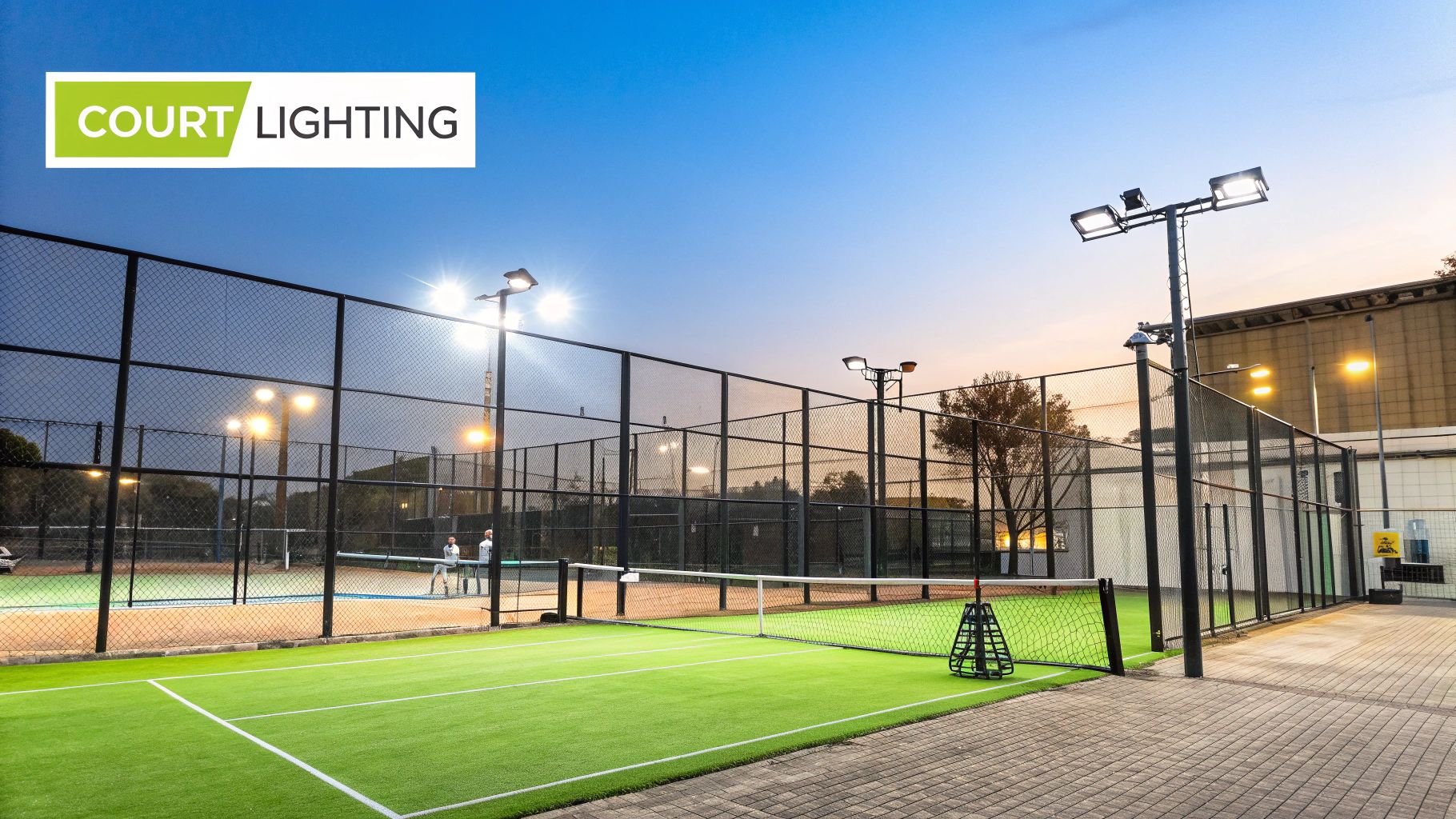
Putting in a brand-new padel court is a huge investment, but the job isn't done when the last screw is tightened. You have to think of your court like a high-performance car; it needs consistent, smart maintenance to perform at its best and keep players safe. If you neglect it, you’re just fast-tracking its decline and wrecking the playing experience for everyone.
Regular upkeep is about so much more than just keeping up appearances. It has a direct impact on player safety, the consistency of the ball bounce, and the lifespan of every single component, from the turf to the steel frame. A proactive maintenance plan is the only way to protect what you've built and make sure your court stays a top-tier facility for years to come.
This approach stops tiny problems—like compacted sand or a loose bolt—from snowballing into expensive, complicated repairs down the line. Let's break down the essential tasks into a simple schedule you can actually follow.
Daily and Weekly Essentials
These are the quick, regular jobs that form the bedrock of good court care. They barely take any time but make a massive difference in preventing long-term damage and making sure the court is always ready for a match.
- Visual Inspection: Before anyone plays, take a quick walk around the court. You're looking for any debris—leaves, twigs, trash—that could mess up a shot or, worse, clog the drainage.
- Net Check: Make sure the net is at the correct height (0.88 meters at the center) and has the right tension. A saggy net completely changes the game.
- Sand Brushing: That silica sand on the artificial turf is everything. At least once or twice a week, the turf needs a good brushing to spread the sand out evenly. This simple task keeps the bounce predictable, protects the turf fibers, and lets players slide safely.
This regular brushing might just be the single most important thing you can do for your playing surface. It stops the sand from getting packed down in high-traffic spots, which can make the court hard and dangerous.
Monthly and Quarterly Routines
Now we step it up a bit. These checks go deeper into the court's structural health, designed to catch wear and tear before it turns into a real headache.
At least once a month, the glass needs a more thorough cleaning. Use a soft cloth or squeegee with a gentle, non-abrasive cleaner to get rid of sweat, handprints, and grime. This isn’t just for the spectators; it's a critical safety measure, as dirty glass can hide small cracks.
Neglected glass isn't just an aesthetic issue; it's a safety hazard. Regular cleaning allows for the early detection of chips or stress fractures, which must be addressed immediately to prevent potential shattering during play.
On top of that, every few months, you need to do a detailed inspection of the whole structure. Check every bolt and fixture on the steel frame and mesh fencing, tightening anything that's worked its way loose. Take a close look for any signs of rust or corrosion—especially if you're in a coastal or humid area—and treat any small spots right away.
Annual Deep Maintenance
Once a year, it's time for the full works: a comprehensive deep clean and a professional check-up. Think of it as your court's annual physical, meant to reset its condition and get it ready for another year of intense play.
This is when you bring in the pros for a deep cleaning of the artificial turf. They use specialized machinery to decompact the sand, pull out deep-seated dirt and organic gunk (which can lead to mold), and get the turf fibers standing upright again. A professional service will likely also top up the silica sand to ensure it's at the perfect depth across the entire court.
Finally, do a complete audit of your lighting system. Clean the fixtures and make sure every LED light is working properly, giving you the uniform lux levels needed for safe night games. A well-maintained padel court isn't just an expense—it’s an asset that delivers a premium experience, game after game.
Building Communities One Court at a Time
A padel court is so much more than just glass, steel, and turf—it's a social engine. Unlike bigger, more isolating sports venues, the cozy, enclosed design of a padel court naturally creates a buzzing, community-focused vibe. It's an instant magnet for people from all walks of life.
The sport's real magic lies in its incredible inclusivity. The smaller court and focus on strategy over brute force mean that age, gender, and athletic history just don't matter as much. You'll see a teenager teaming up with a retiree, or a seasoned athlete having a genuinely competitive match against a newcomer. It's a true social melting pot.
A Hub for All Demographics
This welcoming atmosphere is clearly reflected in the numbers. Padel courts are drawing in a diverse crowd, which has been a massive part of its explosive growth around the world.
You might be surprised to learn that approximately 40% of padel players are female—a remarkably high number for any racket sport. On top of that, the game's appeal spans generations, with active players ranging anywhere from 18 to 70 years old. This is a direct result of its design as a social, low-impact activity. You can dig into more of these fascinating global padel statistics on pala-hack.com.
This wide demographic spread turns a simple sports facility into a real community hub where different groups can mingle and connect. Local courts quickly become the go-to social spot where neighbors catch up, families play together, and new friendships are sparked between matches. It really drives home the point that building a padel court is an investment in social well-being.
By creating a space where health, fun, and social life all come together, a padel court delivers returns that go way beyond the game itself. When you decide to build one, it's crucial to team up with pros who get this vision. Working with trusted padel court builders ensures you’re not just putting up a playing area, but creating a lasting community asset. After all, the global padel movement is built on this very foundation of connection, one court at a time.
Common Questions About Padel Tennis Courts
As padel's popularity explodes worldwide, a lot of practical questions pop up for anyone thinking about building a court, adding them to a club, or even just getting into the game. Getting a handle on the nuts and bolts of a padel court is step one.
So, let's clear up some of the most common queries.
How Much Space Do You Really Need?
The court itself is 20 meters by 10 meters, but don't mistake that for the final footprint. To do it right, you've got to factor in the steel structure, the entrances for players, and a bit of a safety buffer around the whole thing.
A good rule of thumb is to plan for a total space of at least 22 by 12 meters. That extra room is crucial for the foundation and the structure itself. If you're dreaming bigger and planning a facility with multiple courts side-by-side, it's smart to leave one or two meters between them. This gives people comfortable walking space and room for spectators to catch the action.
Can You Convert a Tennis Court into a Padel Court?
Absolutely. In fact, it's becoming a go-to move for tennis clubs looking to tap into the padel craze. A standard tennis court gives you more than enough real estate to work with. You can usually fit two, and sometimes even three, padel courts right where a single tennis court used to be.
The real make-or-break factor here is the existing base. Before you do anything, you need a professional to check out the tennis court's foundation. They'll make sure it's level, stable, and drains properly. Building on a bad base is just asking for expensive structural headaches down the road.
What Is a Panoramic Versus a Classic Court?
The big difference between a "classic" and a "panoramic" court is all about the back walls and how they affect the view for anyone watching.
- Classic Courts: These are the standard design. They have visible steel posts or pillars holding up the big glass panels at either end of the court.
- Panoramic Courts: This is the premium, pro-level setup. The design uses thicker, reinforced glass and a clever frame to get rid of those back-wall posts completely. The result is a clean, sweeping, and totally unobstructed view of the game—which is why it's the top choice for professional tournaments and TV broadcasts.
While panoramic courts look incredible and offer an unmatched viewing experience, that advanced engineering and those specialized materials mean they come with a higher price tag.
How Long Does Installation Take?
Once all the permits are sorted and the planning is done, the actual on-site build is faster than most people think. For a typical outdoor padel court, you can expect the installation to take somewhere between one and three weeks.
Of course, that timeline can shift a bit depending on how much groundwork is needed and whether the weather decides to cooperate. The process is pretty straightforward: prepare the foundation, put up the steel and glass structure, roll out the artificial turf, spread the sand, and hook up the lights.
Ready to dive deeper into the world of padel? At Padel Rumors, we have everything you need, from expert guides on rules and equipment to the latest news from the pro tours. Explore our resources and join the global padel community today at https://padelrumors.pages.dev.


